Assessment of Two Adjacent Mountainous Riparian Areas along Nestos River Tributaries of Greece
Abstract
:1. Introduction
2. Materials and Methods
2.1. Study Area
2.2. Fluvio-Geomorphologic Measurements
2.2.1. Watershed Scale—GIS
2.2.2. Field Measurements
2.3. Riparian Vegetation Identification and Evaluation
2.3.1. Vegetation Species Survey
2.3.2. Riparian Forest Quality (QBR) Protocol
2.3.3. Riparian Forest Evaluation (RFV) Protocol
2.3.4. Visual Protocols Statistical Analysis
2.4. Ground-Dwelling Insects
2.4.1. Pitfall Traps
2.4.2. Population and Diversity Indices
3. Results
3.1. Fluvio-Geomorphologic Parameters
3.2. Vegetation Identification and Evaluation
3.3. Ground-Dwelling Insects
4. Discussion
5. Conclusions
Author Contributions
Funding
Conflicts of Interest
References
- Geijzendorffer, I.R.; Beltrame, C.; Chazee, L.; Gaget, E.; Galewski, T.; Guelmami, A.; Perennou, C.; Popoff, N.; Guerra, C.; Leberger, R.; et al. A more effective Ramsar Convention for the conservation of Mediterranean wetlands. Front Ecol. Evol. 2019, 7, 21. [Google Scholar] [CrossRef] [Green Version]
- Bruno, D.; Gutierrez-Canovas, C.; Sanchez-Fernandez, D.; Velasco, J.; Nilsson, C. Impacts of environmental filters on functional redundancy in riparian vegetation. J Appl. Ecol. 2016, 53, 846–855. [Google Scholar] [CrossRef] [Green Version]
- Aguiar, F.C.; Segurado, P.; Martins, M.J.; Bejarano, M.D.; Nilsson, C.; Portela, M.M.; Merritt, D.M. The abundance and distribution of guilds of riparian woody plants change in response to land use and flow regulation. J. Appl. Ecol. 2018, 55, 2227–2240. [Google Scholar] [CrossRef]
- García-Nieto, A.P.; Geijzendorffer, I.; Baró, F.; Roche, P.; Bondeau, A.; Cramer, W. Impacts of urbanization around Mediterranean cities: Changes in ecosystem service supply. Ecol. Indic. 2018, 91, 589–606. [Google Scholar] [CrossRef] [Green Version]
- Stefanidis, K.; Latsiou, A.; Kouvarda, T.; Lampou, A.; Kalaitzakis, N.; Gritzalis, K.; Dimitriou, E. Disentangling the main components of hydromorphological modifications at reach scale in rivers of Greece. Hydrology 2020, 7, 22. [Google Scholar] [CrossRef] [Green Version]
- Zaimes, G.N.; Gounaridis, D.; Fotakis, D. Assessing riparian land-uses/vegetation cover along the Nestos River in Greece. Fresen Environ. Bull. 2011, 20, 3217–3225. [Google Scholar]
- Patten, D. Riparian ecosystems of semi-arid North America: Diversity and human impacts. Wetlands 1998, 18, 498–512. [Google Scholar] [CrossRef]
- Zaimes, G.N. 2020. Mediterranean Riparian Areas-Climate change implications and recommendations. J. Environ. Biol. 2020, 41, 957–965. [Google Scholar] [CrossRef]
- Rodríguez-Lozano, P.; Rieradevall, M.; Andrei Rau, M.; Prat, N. Long-term consequences of a wildfire for leaf-litter breakdown in a Mediterranean stream. Freshw. Sci. 2015, 34, 1482–1493. [Google Scholar] [CrossRef]
- Cid, N.; Bonada, N.; Carlson, S.M.; Grantham, T.E.; Gasith, A.; Resh, V.H. High variability is a defining component of Mediterranean-Climate rivers and their biota. Water 2017, 9, 52. [Google Scholar] [CrossRef] [Green Version]
- Lobera, G.; Batalla, R.J.; Vericat, D.; Lopez-Tarazin, J.A.; Tena, A. Sediment transport in two Mediterranean regulated rivers. Sci. Total Environ. 2016, 540, 101–113. [Google Scholar] [CrossRef]
- Emmanouloudis, D.; Garcia Rodriguez, J.L.; Zaimes, G.N.; Giminez Suarez, M.C.; Filippidis, E. Euro-Mediterranean torrents: Case studies on tools that can improve their management. In Mountain Ecosystems: Dynamics, Management and Conservation; Richards, K.E., Ed.; Nova Science Publishers: Hauppauge, NY, USA, 2011; pp. 1–44. [Google Scholar]
- Guida, D.; Cuomo, A.; Longobardi, A.; Villani, P. Geohydrology of a Reference Mediterranean Catchment (Cilento UNESCO Geopark, Southern Italy). Appl. Sci. 2020, 10, 4117. [Google Scholar] [CrossRef]
- Tolkkinen, M.J.; Heino, J.; Ahonen, S.H.K.; Lehosmaa, K.; Mykrä, H. Streams and riparian forests depend on each other: A review with a special focus on microbes. Ecol. Manag. 2020, 462, 117962. [Google Scholar] [CrossRef]
- Zaimes, G.N.; Loisios, P.; Fytopoulos, P.; Mersina, C.; Fyllas, N.; Iakovoglou, V.; Avtzis, D. Ground dwelling insects as environmental indicators of riparian habitats in agricultural Mediterranean landscapes. Environ. Eng. Manag. J. 2019, 18, 1977–1986. [Google Scholar] [CrossRef]
- Bonada, N.; Dolédec, S.; Statzner, B. Taxonomic and biological trait differences of stream macroinvertebrate communities between Mediterranean and temperate regions. Implications for future climatic scenarios. Glob. Chang. Biol. 2007, 13, 1658–1671. [Google Scholar] [CrossRef]
- Santos, M.J. Encroachment of upland Mediterranean plant species in riparian ecosystems of southern Portugal. Biodivers. Conserv. 2010, 19, 2667–2684. [Google Scholar] [CrossRef] [Green Version]
- Naiman, R.J.; Decamps, H.; McClain, M.E. Riparia: Ecology, Conservation, and Management of Streamside Communities; Elsevier Acad. Press: London, UK, 2005. [Google Scholar]
- Balzan, M.V.; Hassoun, A.E.R.; Aroua, N.; Baldy, V.; Bou Dagher, M.; Branquinho, C.; Dutay, J.C.; El Bour, M.; Médail, F.; Mojtahid, M.; et al. Ecosystems. In Climate and Environmental Change in the Mediterranean Basin–Current Situation and Risks for the Future. First Mediterranean Assessment Report; Cramer, W., Guiot, J., Marini, K., Eds.; Union for the Mediterranean, Plan Bleu, UNEP/MAP: Marseille, France, 2020; p. 151. [Google Scholar]
- Terrado, M.; Acuna, V.; Ennaanay, D.; Tallis, T.; Sabater, S. Impact of climate extremes on hydrological ecosystem services in a heavily humanized Mediterranean basin. Ecol. Indic. 2014, 37, 199–209. [Google Scholar] [CrossRef]
- Rault, P.A.; Koundouri, P.; Akinsete, E.; Ludwig, R.; Huber-Garcia, V.; Tsani, S.; Acuna, V.; Kalogianni, E.; Luttik, J.; Kokg, K.; et al. Down scaling of climate change scenarii to river basin level: A transdisciplinary methodology applied to Evrotas river basin, Greece. Sci. Total Environ. 2019, 660, 1623–1632. [Google Scholar] [CrossRef] [PubMed]
- Calbo, J. Possible climate change scenarios with specific reference to Mediterranean regions. In Water Scarcity in the Mediterranean; Sabater, S.D., Barceló, D., Eds.; Springer: Berlin, Germany, 2010; pp. 1–13. [Google Scholar]
- Lelieveld, J.; Hadjinicolaou, P.; Kostopoulou, E.; Chenoweth, E.; Maayar, M.; Giannakopoulos, C.; Hannides, C.; Lange, M.A.; Tanarhte, M.; Tyrlis, E.; et al. Climate change and impacts in the Eastern Mediterranean and the Middle East. Clim. Chang. 2012, 114, 667–687. [Google Scholar] [CrossRef] [Green Version]
- Belmar, O.; Bruno, D.; Martínez-Capel, F.; Barquín, J.; Velasco, J. Effects of flow regime alteration on fluvial habitats and riparian quality in a semiarid Mediterranean basin. Ecol. Indic. 2013, 30, 52–64. [Google Scholar] [CrossRef]
- Leo, M.; Calleja, J.A.; Lara, F.; Garilleti, R.; Medina, N. G: Drivers of plant richness patterns of Mediterranean riparian forests at local and regional scales have bottom-up and top-down effects. J. Veg. Sci. 2019, 30, 485–497. [Google Scholar] [CrossRef]
- Zaimes, G.N.; Gounaridis, D.; Symeonakis, E. Assessing the impact of dams on riparian and deltaic vegetation using remotely-sensed vegetation indices and Random Forests modelling. Ecol. Indic. 2019, 103, 630–641. [Google Scholar] [CrossRef]
- Garófano-Gomez, V.; Martınez-Capel, F.; Peredo-Parada, M.; Julia, E.; Marın, O.; Munoz, M.R.; Soares Costa, M.R.; Pinar-Arenas, J.L. Assessing hydromorphological and floristic patterns along a regulated Mediterranean river: The Serpis River (Spain). Limnetica 2011, 30, 307–328. [Google Scholar]
- Zaimes, G.N.; Iakovoglou, V. Assessing riparian areas of Greece-An overview. Sustainability 2021, 13, 309. [Google Scholar]
- Garcia-Martinez, M.A.; Valenzuela-Gonzalez, J.E.; Escobar-Sarria, F.; Lopez-Barrera, F.; Castaño-Meneses, G. The surrounding landscape influences the diversity of leaf-litter ants in riparian cloud forest remnants. PLoS ONE 2017, 12, e0172464. [Google Scholar] [CrossRef]
- Magdaleno, F.; Fernández-Yuste, J.A. Evolution of the riparian forest corridor in a large Mediterranean river system. Riparian. Ecol. Conserv. 2013, 1, 36–45. [Google Scholar] [CrossRef]
- Mavrommatis, G. The Bioclimate of Greece. Climate and Natural Vegetation Relations, Bioclimate Maps; Institure of Forest Research in Athens: Athens, Greece, 1980. (In Greek) [Google Scholar]
- Fischenich, C. Stability Thresholds for Stream Restoration Materials; EMRRP Technical Notes Collection (ERDC TNEMRRP- SR-29); U.S. Army Engineer Research and Development Center: Vicksburg, MS, USA, 2001. [Google Scholar]
- Leopold, L.B.; Wolman, M.G.; Miller, J.P.; Wohl, E. Fluvial Processes in Geomorphology, 2nd ed.; Dover Publications: Mineola, NY, USA, 2020. [Google Scholar]
- Schumm, S.A.; Harvey, M.D.; Watson, C.C. Incised Channels: Morphology, Dynamics and Control; Water Resources Publications: Littleton, CO, USA, 1984. [Google Scholar]
- Quantitative geomorphology of drainage basins and channel networks. In Handbook of Applied Hydrology; Chow, V.T. (Ed.) McGraw-Hill: New York, NY, USA, 1954; pp. 4.40–4.74. [Google Scholar]
- Harrelson, C.; Rawlins, C.; Potyondy, J. Stream Channel References Sites: An Illustrated Guide to Field Technique; U.S. Department of Agriculture, Forest Service, Rocky Mountain Forest and Range Experiment: Fort Collins, CO, USA, 1994. [Google Scholar]
- Magdaleno, F.; Martinez, R. Evaluating the quality of riparian forest vegetation: The riparian forest evaluation (RVF) index. Forest Syst. 2014, 23, 259–272. [Google Scholar] [CrossRef] [Green Version]
- Arabatzis, T. Shrubs and Trees in Greece Vol 1; Technological Educational Institute of Kavala: Drama, Greece, 1998. [Google Scholar]
- Arabatzis, T. Shrubs and Trees in Greece Vol 2; Technological Educational Institute of Kavala: Drama, Greece, 2002. [Google Scholar]
- Stefanatos, A. Trees and Shrubs of Forests in Eastern Macedonia and Thrace; Prefecture of Kavala: Kavala, Greece, 2009. [Google Scholar]
- Zogaris, S.; Hatzivarsanis, V.; Economou, A.N.; Hatzinikolaou, Y.; Giakoumi, S.; Dimopoulos, N. Riparian Zones in Greece: Protecting Riverine Oasis of Life; HCMR & IIM: Athens, Greece, 2007. [Google Scholar]
- Munné, A.; Prat, N.; Solà, C.; Bonada, N.; Rieradevall, M. A simple field method for assessing the ecological quality of riparian habitat in rivers and streams: QBR index. Aquat. Conserv. 2003, 13, 147–163. [Google Scholar] [CrossRef]
- Mullen, K.; O’Halloran, J.; Breen, J.; Giller, P.; Pithon, J.; Kelly, T. Distribution and composition of carabid beetle (Coleoptera, Carabidae) communities across the plantation forest cycle—Implications for management. For. Ecol. Manag. 2008, 256, 624–632. [Google Scholar]
- Yu, X.; Luo, T.; Zhou, H. Habitat associations and seasonal activity of carabid beetles (Coleoptera: Carabidae) in Dongling Mountain, North China. Entomol. Fenn. 2006, 17, 174–183. [Google Scholar] [CrossRef] [Green Version]
- Heliola, J.; Koivula, M.; Niemela, J. Distribution of carabid beetles (Coleoptera, Carabidae) across a boreal forest–clearcut ecotone. Conserv. Biol. 2001, 15, 370–377. [Google Scholar] [CrossRef]
- Bellmann, H. Welches Insekt ist das? 2nd ed.; Franckh Kosmos Editions: Stuttgart, Germany, 2011. [Google Scholar]
- Bellmann, H. Der neue Kosmos-Insektenführer, 2nd ed.; Franckh Kosmos Editions: Stuttgart, Germany, 2009. [Google Scholar]
- Chinery, M. Pareys Buch der Insekten, 2nd ed.; Franckh Kosmos Editions: Stuttgart, Germany, 2012. [Google Scholar]
- Simpson, E.H. Measurement of diversity. Nature 1979, 163, 688. [Google Scholar] [CrossRef]
- Shannon, C.E.; Weaver, W. A mathematical theory of communication. Bell. Syst. Tech. J. 1948, 27, 379–423. [Google Scholar] [CrossRef] [Green Version]
- Katusiime, J.; Schütt, B. Integrated Water Resources Management Approaches to Improve Water Resources Governance. Water 2020, 12, 3424. [Google Scholar] [CrossRef]
- Zaimes, G.N.; Emmanouloudis, D. Sustainable Management of the Freshwater Resources of Greece. J. Eng. Sci. Technol. 2012, 5, 77–82. [Google Scholar] [CrossRef]
- Yani, D.A.; Bisri, M.; Montarcih Limantara, L.; Suhartanto, E. Model flood peak discharge based on the watershed shape factor. Int. J. Civ. Eng. Technol. 2018, 9, 906–917. [Google Scholar]
- Zaimes, G.N.; Tardio, G.; Iakovoglou, V.; Gimenez, M.; Garcia-Rodriguez, J.L.; Sangalli, P. New tools and approaches to promote soil and water bioengineering in the Mediterranean. Sci. Total Environ. 2019, 693, 133677. [Google Scholar] [CrossRef] [PubMed]
- Kaufmann, P.R.; Larsen, D.P.; Faustini, J.M. Bed stability and sedimentation associated with human disturbances in Pacific Northwest streams. J. Am. Water Resour. Assoc. 2009, 45, 434–459. [Google Scholar] [CrossRef]
- Mishra, A.; Alnahit, A.; Campbell, B. Impact of land uses, drought, flood, wildfire, and cascading events on water quality and microbial communities: A review and analysis. J. Hydrol. 2021, 596, 125707. [Google Scholar] [CrossRef]
- Bombino, G.; Gurnell, A.M.; Tamburino, V.; Zema, D.A.; Zimbone, S.M. Sediment size variation in torrents with check dams: Effects on riparian vegetation. Ecol. Eng. 2008, 1, 166–177. [Google Scholar] [CrossRef]
- Itsukushim, R. Influence of stream channel characteristics on bed morphology and step–pool structure in a rhyolitic headstream watershed. Catena 2021, 204, 105427. [Google Scholar] [CrossRef]
- Stella, J.C.; Riddle, J.; Piégay, H.; Gagnage, M.; Trémélo, M.-L. Climate and local geomorphic interactions drive patterns of riparian forest decline along a Mediterranean Basin river. Geomorphology 2013, 202, 101–114. [Google Scholar] [CrossRef]
- Chapman, J.M.; Proulx, C.L.; Veilleux, M.A.N.; Levert, C.; Bliss, S.; André, M.; Lapointe, N.W.R.; Cooke, S.J. Clear as mud: A meta-analysis on the effects of sedimentation on freshwater fish and the effectiveness of sediment-control measures. Water Res. 2014, 56, 190–202. [Google Scholar] [CrossRef] [PubMed]
- Wilcock, P.R. The components of fractional transport rate. Water Resour. Res. 1997, 33, 247–258. [Google Scholar] [CrossRef]
- Owens, P.N.; Batalla, R.J.; Collins, A.J.; Gomez, B.; Hicks, D.M.; Horowitz, A.J.; Kondolf, G.M.; Marden, M.; Page, M.J.; Peacock, D.H.; et al. Fine-grained sediment in river systems: Environmental significance and management issues. River. Res. Appl. 2005, 21, 693–717. [Google Scholar] [CrossRef]
- Finnegan, N.J.; Roe, G.; Montgomery, D.R.; Hallet, B. Controls on the channel width of rivers: Implications for modeling fluvial incision of bedrock. Geology 2005, 33, 229–232. [Google Scholar] [CrossRef] [Green Version]
- Zaimes, G.N.; Tufekcioglu, M.; Schultz, R.C. Riparian land-use impacts on stream bank and gully erosion in agricultural watersheds: What we have learned. Water 2019, 11, 1343. [Google Scholar] [CrossRef] [Green Version]
- Skoulikidis, N.T.; Karaouzas, I.; Amaxidis, Y.; Lazaridou, M. Impact of EU environmental policy implementation on the quality and status of Greek rivers. Water 2021, 13, 1858. [Google Scholar] [CrossRef]
- Fonseca, A.; Ugille, J.-P.; Michez, A.; Rodríguez-González, P.M.; Duarte, G.; Ferreira, M.T.; Fernandes, M.R. Assessing the Connectivity of Riparian Forests across a Gradient of Human Disturbance: The Potential of Copernicus “Riparian Zones” in Two Hydroregions. Forests 2021, 12, 674. [Google Scholar] [CrossRef]
- Latsiou, A.; Kouvarda, T.; Stefanidis, K.; Papaioannou, G.; Gritzalis, K.; Dimitriou, E. Pressures and status of the riparian vegetation in Greek Rivers: Overview and preliminary assessment. Hydrology 2021, 8, 55. [Google Scholar] [CrossRef]
- Kasapidis, K.; Giatas, G.; Pagonis, G.; Kiourtziadis, P.; Iakovoglou, V.; Zaimes, G.N. Assessing mountainous riparian areas of North Greece adjacent to forested and rural areas with the use of GIS, SVAP and QBR. In Proceedings of the Sixth International Conference on Environmental Management, Engineering, Planning & Economics, Thessaloniki, Greece, 25–30 June 2017; pp. 1167–1178. [Google Scholar]
- Zogaris, S.; Chatzinikolaou, Y.; Dimopoulos, P. Assessing environmental degradation of montane riparian zones in Greece. J Envrion. Biol. 2009, 30, 719–726. [Google Scholar]
- Bruno, D.; Belmar, O.; Sánchez-Fernández, D.; Guareschi, S.; Millán, A.; Velasco, J. Responses of Mediterranean aquatic and riparian communities to human pressures at different spatial scales. Ecol. Indic. 2014, 45, 456–464. [Google Scholar] [CrossRef]
- Rouabah, A.; Villerd, J.; Amiaud, B.; Plantureux, S.; Lasserre-Joulin, F. Response of carabid beetles diversity and size distribution to the vegetation structure within differently managed field margins. Agric. Ecosyst. Environ. 2015, 200, 21–32. [Google Scholar] [CrossRef]
- Perry, K.I.; Herms, D.A. Dynamic responses of ground-dwelling invertebrate communities to disturbance in forest ecosystems. Insects 2019, 10, 61. [Google Scholar] [CrossRef] [PubMed] [Green Version]
- Xiao, H.; Du, C.; Yuan, Y.; Li, B. Multiple floods affect composition and community structure of the ground-dwelling arthropods in the riparian zone of the Three Gorges Reservoir. Ecol. Indic. 2020, 113, 106220. [Google Scholar] [CrossRef]
- Skalski, T.; Kędzior, R.; Radecki-Pawlik, A. Riparian ground beetles in gravel bed rivers: Validation of Invertebrate Bankfull Assessment method. Sci. Total Environ. 2020, 707, 135572. [Google Scholar] [CrossRef]
- Baker, S.; Richardson, A.; Barmuta, L. Site effects outweigh riparian influences on ground-dwelling beetles adjacent to first order streams in wet eucalypt forest. Biodivers. Conserv. 2007, 16, 1999–2014. [Google Scholar] [CrossRef]
- Idris, N.S.; Mustapha, M.A.; Sulaiman, N.; Khamis, S.; Husin, S.M.; Darbis, N.D.A. The dynamics of landscape changes surrounding a firefly ecotourism area. Glob. Ecol. Conserv. 2021, 29, e01741. [Google Scholar] [CrossRef]
- Vidal-Abarca Gutiérrez, M.R.; Suárez Alonso, M.L. Which are, what is their status and what can we expect from ecosystem services provided by Spanish rivers and riparian areas? Biodivers. Conserv. 2013, 22, 2469–2503. [Google Scholar] [CrossRef]


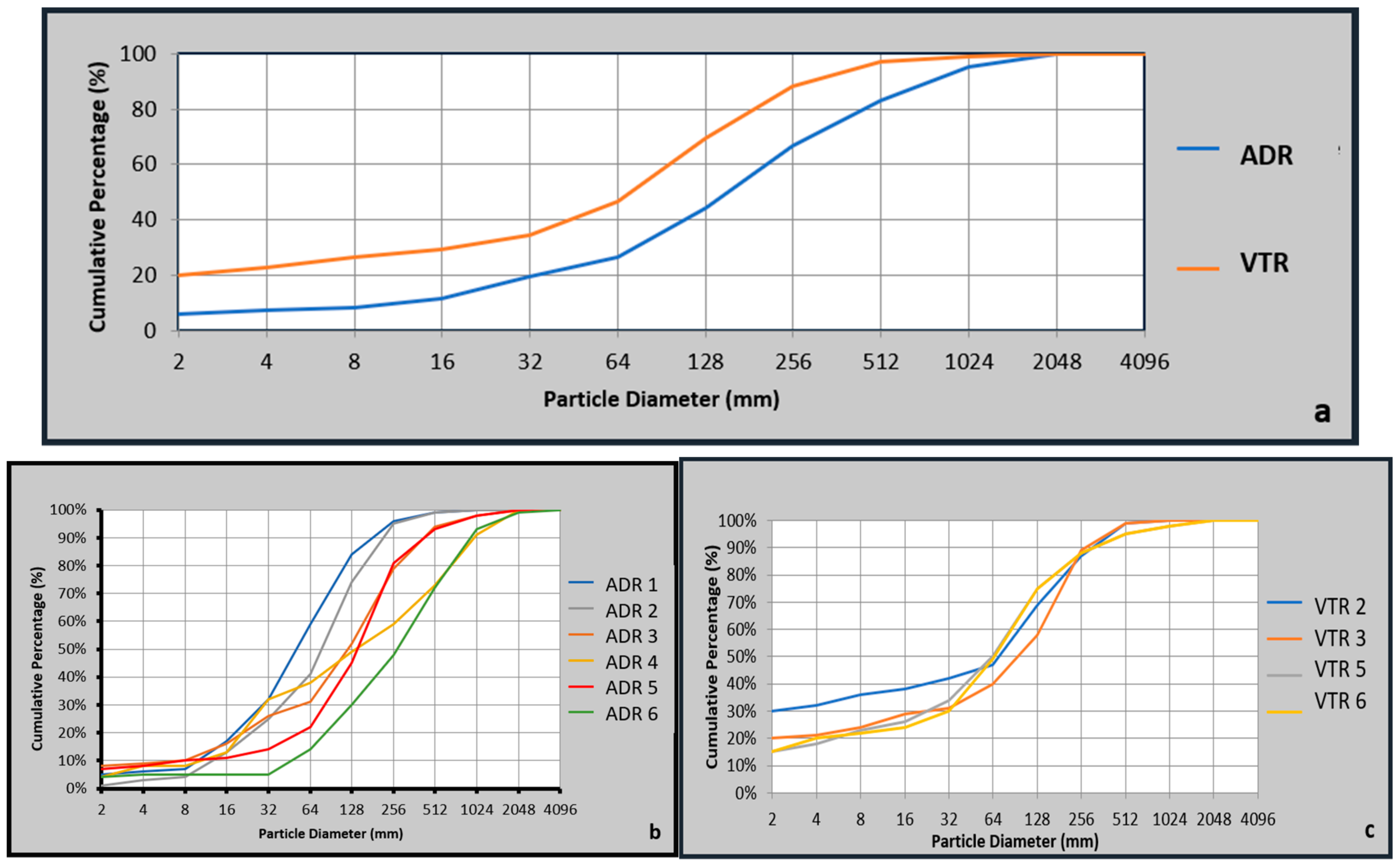
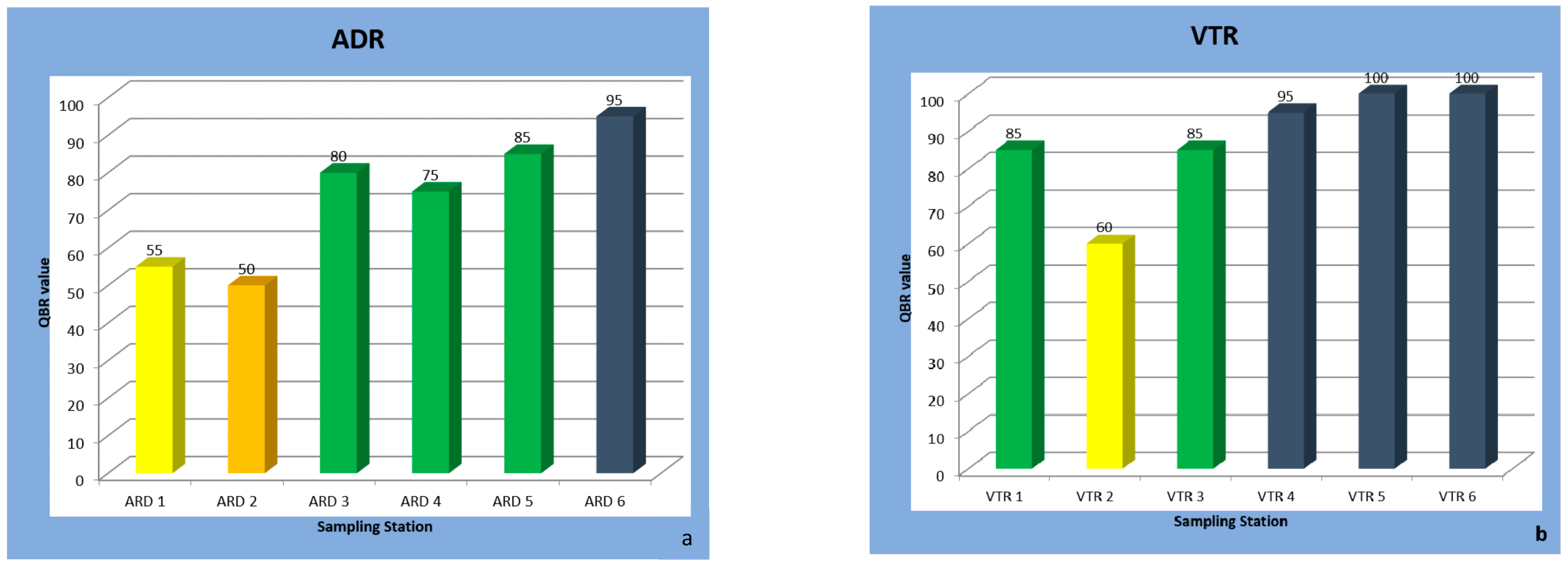
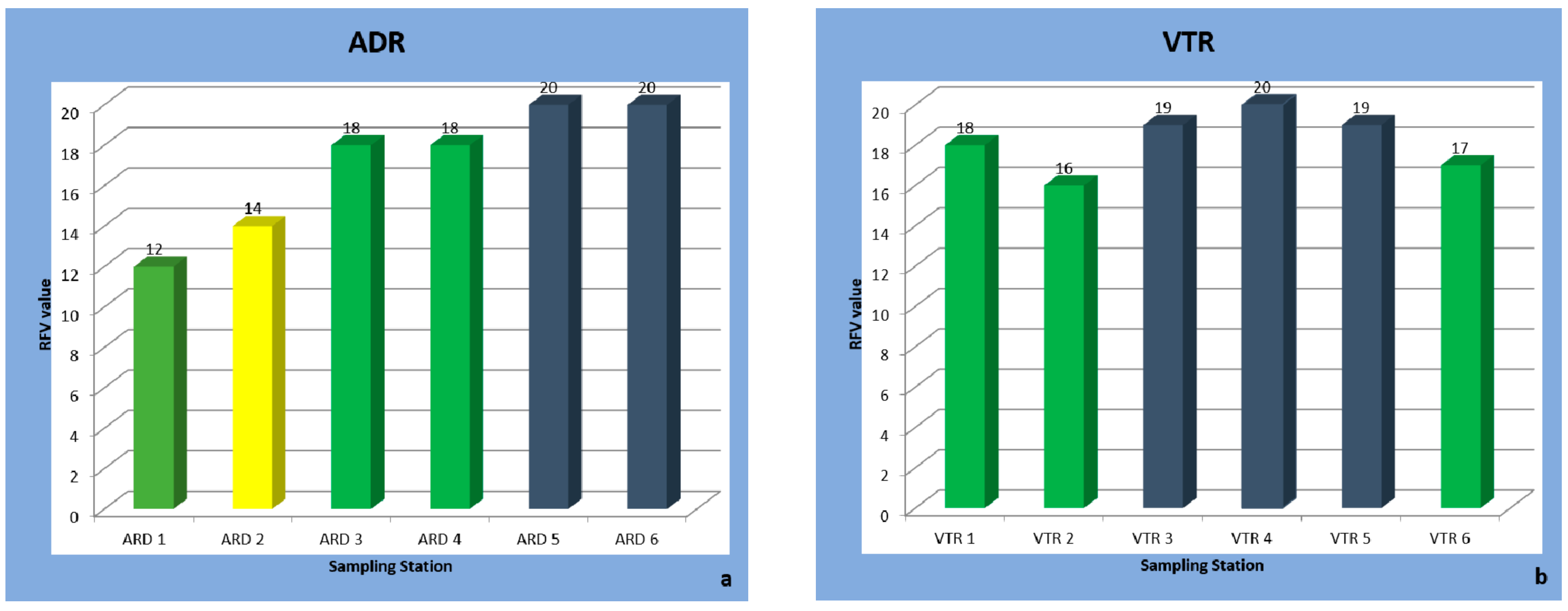
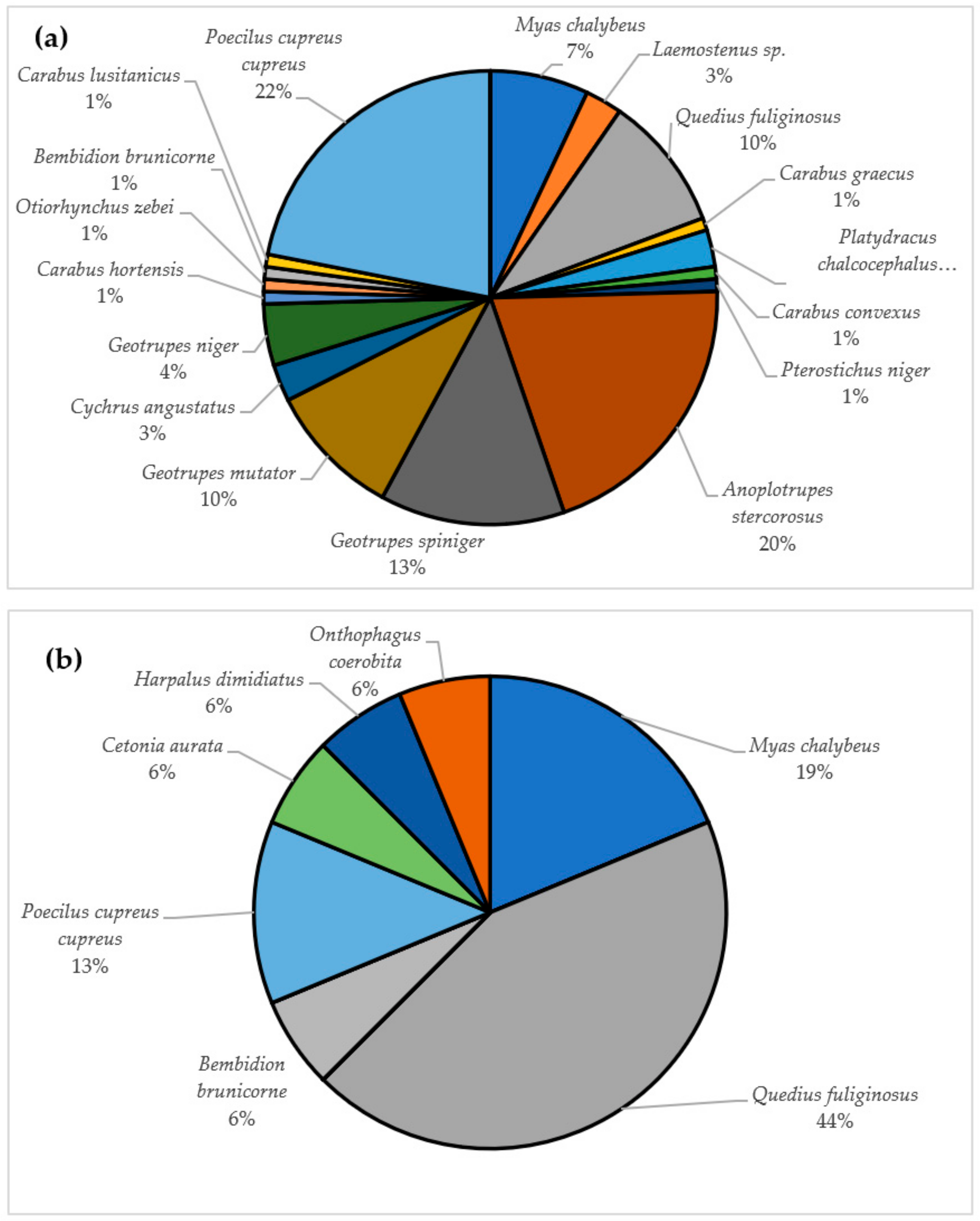
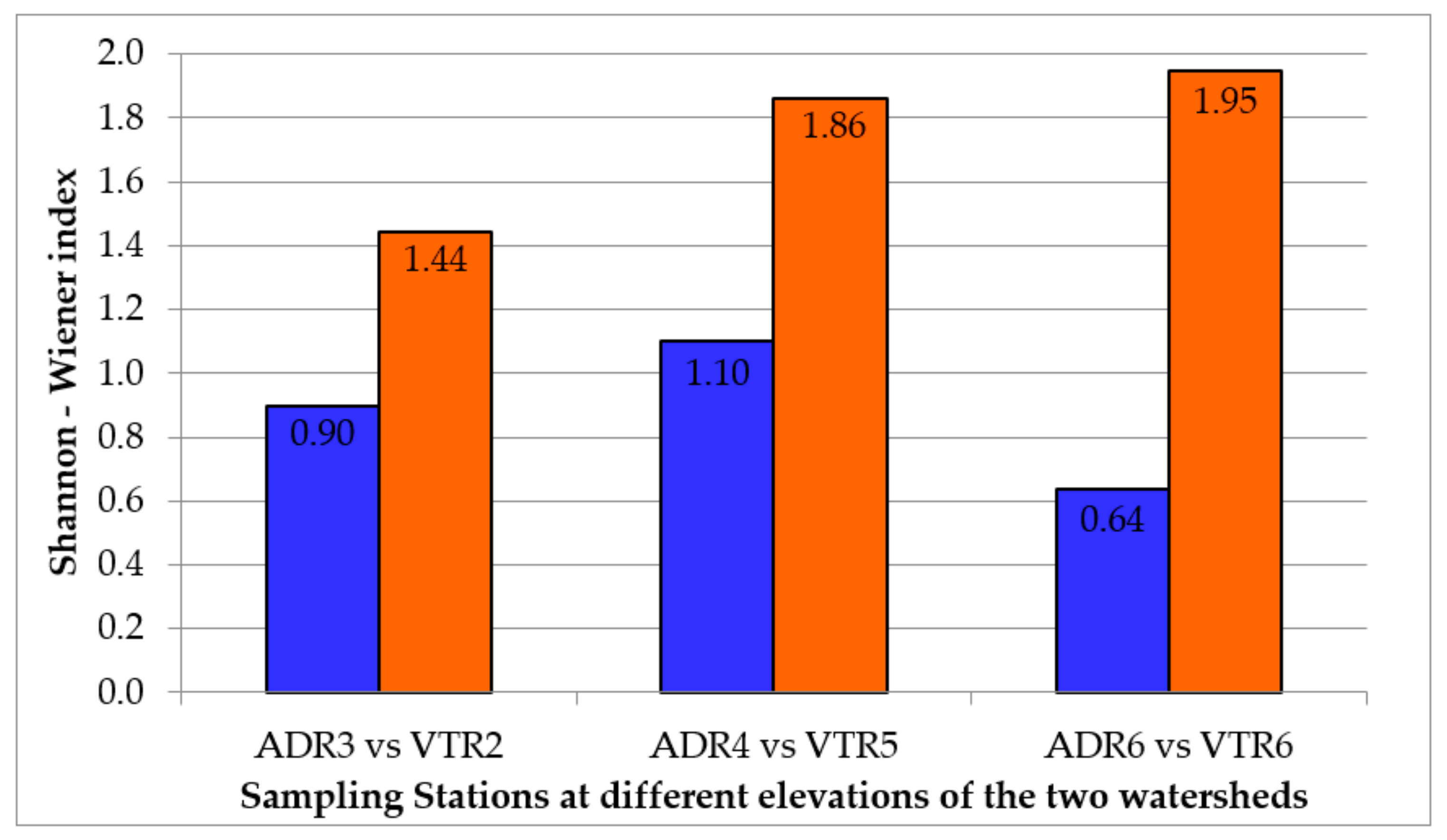
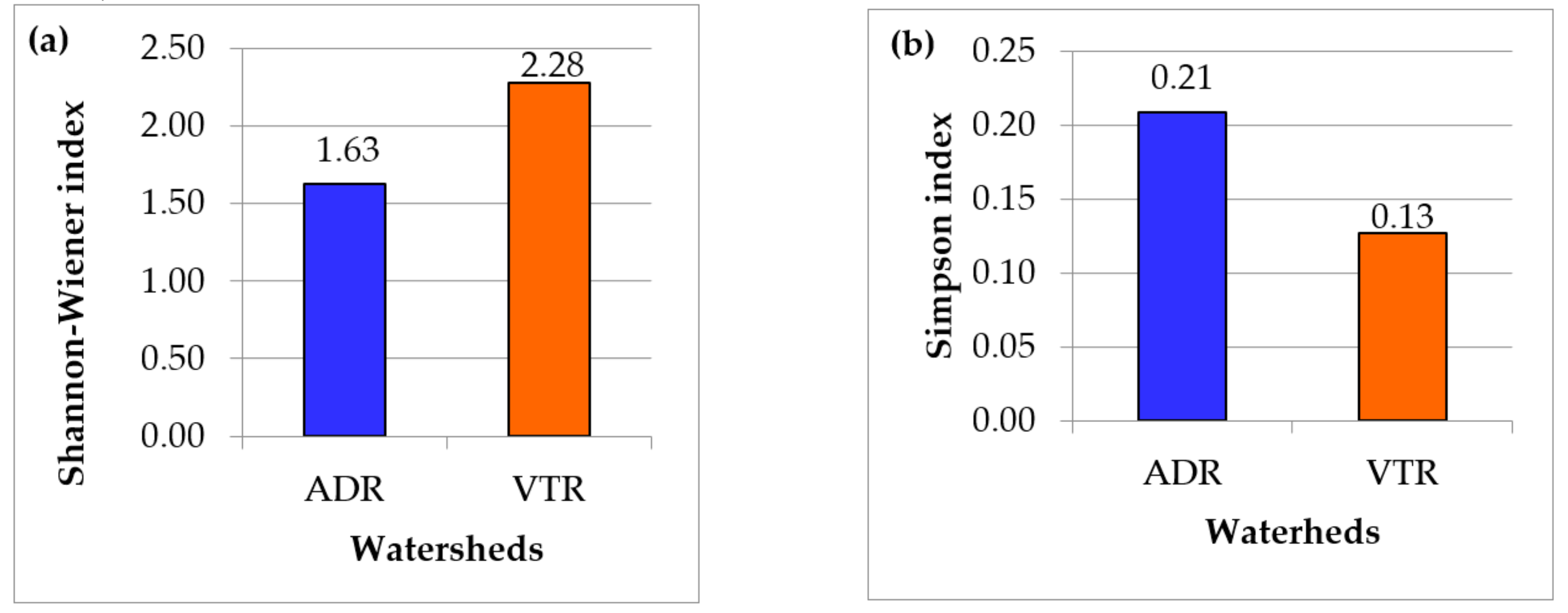
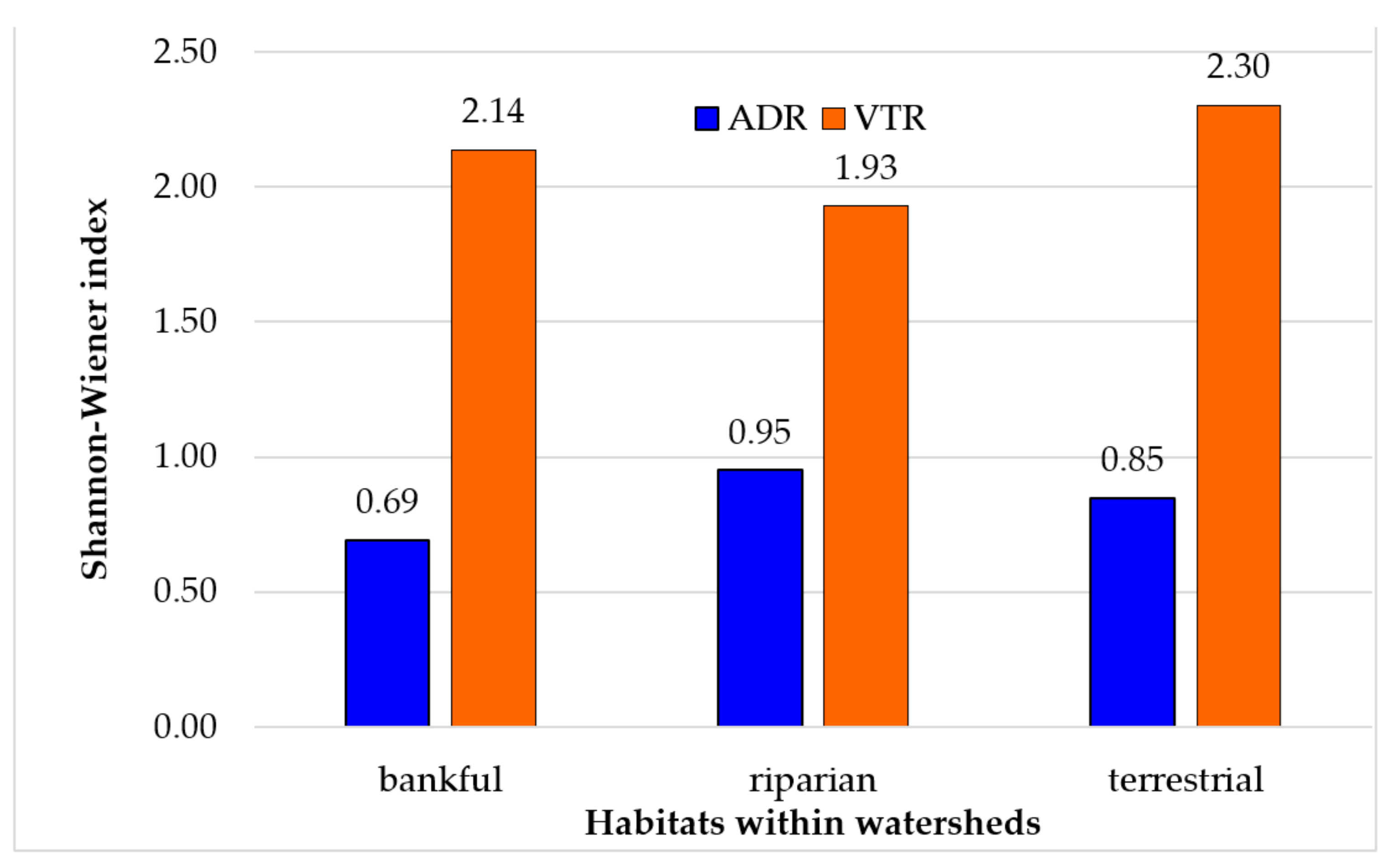
| Sampling Station | Elevation (m) | Fluvio-Geomorphologic Meas. | Riparian Veget. Evaluation | Insect Traps | ||
|---|---|---|---|---|---|---|
| QBR 1 | RFV 2 | Vegetation | ||||
| Arkoudorema (ADR) | ||||||
| ADR 1 | 144 | X | X | X | X | |
| ADR 2 | 168 | X | X | X | X | |
| ADR 3 | 247 | X | X | X | X | X |
| ADR 4 | 375 | X | X | X | X | X |
| ADR 5 | 462 | X | X | X | X | |
| ADR 6 | 1092 | X | X | X | X | X |
| ADR 7 | 1419 | X | X | |||
| Vathirema (VTR) | ||||||
| VTR 1 | 406 | X | X | X | X | |
| VTR 2 | 458 | X | X | X | X | X |
| VTR 3 | 505 | X | X | X | X | X |
| VTR 4 | 625 | X | X | X | X | |
| VTR 5 | 924 | X | X | X | X | |
| VTR 6 | 1191 | X | X | X | X | X |
| VTR 7 | 1357 | X | X | |||
| Parameters | Unit | Arkoudorema | Vathirema |
|---|---|---|---|
| Watershed | |||
| Area | km2 | 284.6 | 201.0 |
| Perimeter | km | 93.0 | 75.5 |
| Max elevation | m | 1761 | 1825 |
| Min elevation | m | 131 | 335 |
| Mean altitude | m | 1142 | 1160 |
| Relief | m | 1630 | 1550 |
| Slope max | % | 98 | 84 |
| Slope min | % | 0.016 | 0.002 |
| Slope mean | % | 22 | 15 |
| Length | km | 37.5 | 35.3 |
| Shape | km2/km2 | 0.05 | 0.06 |
| Roundness degree | km2/km | 3.1 | 2.7 |
| Stream | |||
| Total length | km | 1180.6 | 793.5 |
| Drainage density | km/km2 | 4.1 | 3.9 |
| Shreve stream order | - | 3271 | 1688 |
| Strahler stream order | - | 7 | 6 |
| Ruggedness | km km/km2 | 6.6 | 5.9 |
| Relief ratio | km/km | 43.5 | 42.8 |
| Relative stream power | km2 | 12.4 | 8.6 |
| Sampling Station | Strahler Order | Water Surface Width (m) | Bankfull Width (m) | Bank Slope Category | ||
|---|---|---|---|---|---|---|
| Left | Right | Left | Right | |||
| ADR 1 | 7 | 22.40 | n/m * | n/m * | 3 | 1 |
| ADR 2 | 7 | 20.20 | n/m * | n/m * | 3 | 2 |
| ADR 3 | 7 | 14.70 | 2.02 | 1.2 | 2 | 3 |
| ADR 4 | 6 | 10.80 | 1.0 | 0.5 | 1 | 3 |
| ADR 5 | 6 | 17.95 | 5.0 | 5.0 | 1 | 2 |
| ADR 6 | 3 | 5.30 | 0.3 | 0.5 | 3 | 3 |
| ADR 7 | 3 | 3.70 | 0.3 | 0.4 | 3 | 3 |
| VTR 1 | 6 | 9.60 | 1.4 | 1.0 | 2 | 3 |
| VTR 2 | 6 | 12.80 | 11.1 | 1.0 | 2 | 3 |
| VTR 3 | 6 | 14.20 | n/m * | n/m * | 2 | 2 |
| VTR 4 | 6 | 9.80 | 2.5 | 0.8 | 2 | 3 |
| VTR 5 | 6 | 7.90 | 1.7 | 0.3 | 3 | 3 |
| VTR 6 | 5 | 4.60 | 0.7 | 1.0 | 3 | 3 |
| VTR 7 | 4 | 2.30 | 0.3 | 0.4 | 3 | 3 |
| Sampling Station | Riparian Zone | Terrestrial Zone | Forest Habitat Type (NATURA 2000 Code) | ||
|---|---|---|---|---|---|
| Dominant | Subdominant | Shrubs | |||
| VTR 1 | Alnus glutinosa L. | Malus dasyphylla Borkh. | Rubus sanctus Schreb. | Quercus robur L. | Alno-Pandion, Alnion incanae, Salicion Albae (91EO) |
| Corylus avellana L. | Salix sp. | ||||
| Fraxinus ornus L. | |||||
| VTR 2 | Alnus glutinosa | Malus dasyphylla | Quercus robur | Alno-Pandion, Alnion incanae, Salicion Albae (91EO) | |
| Corylus avellana | Ostrya carpinifolia | ||||
| Carpinus betulus L. | Populus × canadensis | ||||
| VTR 3 | Alnus glutinosa | Cornus sanguinea L. | Carpinus orientalis Mill. | Alno-Pandion, Alnion incanae, Salicion Albae (91EO) | |
| Carpinus betulus | Juglans regia L. | ||||
| Salix sp. | |||||
| VTR 4 | Ostrya carpinifolia Scop. | Cornus mas L. | Fagus sylvatica | Alno-Pandion, Alnion incanae, Salicion Albae (91EO) | |
| Corylus avellana | Carpinus orientalis | ||||
| Alnus glutinosa | |||||
| VTR 5 | Fagus sylvatica L. | Corylus avellana | Pinus sylvestris | Asperulo-Fagetum beech forests (9130) | |
| Picea abies | Carpinus orientalis | ||||
| Salix alba | Quercus robur | ||||
| VTR 6 | Pinus sylvestris L. | Populus tremula L. | Rosa tomentosa Sm. | Pinus sylvestris | Rhodopide and Balkan Range Scots pine forests (91CA) |
| Picea abies L. H. Karst. | Betula pendula Roth. | ||||
| Corylus avellana | |||||
| Salix alba | |||||
| Fagus sylvatica | |||||
| VTR 7 | Pinus sylvestris | Salix caprea L. | Salix elaeagnos Scop. | Pinus sylvestris | Rhodopide and Balkan Range Scots pine forests (91CA) |
| Picea abies | Picea abies | ||||
| Abies borisii-regis Mattf. | Abies borisιi -regis | ||||
| Alnus glutinosa | Cornus sanguinea L. | Carpinus orientalis | |||
| ADR 1 | Salix alba L. | Alnus glutinosa | Salix purpurea L. | Salix alba and Populus alba galleries (92A0) | |
| Platanus orientalis L. | Salix cinerea L. | ||||
| Salix elaeagnos | |||||
| Rubus sanctus | |||||
| ADR 2 | Alnus glutinosa | Paliurus spina-christi Mill. | Salix elaeagnos | Alno--Pandion, Alnion incanae, Salicion Albae (91EO) | |
| Robinia pseudoacacia L. | |||||
| ADR 3 | Salix sp | Prunus spinosa L. | Hedera helix L. | Carpinus orientalis | Alnon Pandion, Alnion incanae, Salicion Albae (91EO) |
| Alnus glutinosa | Cornus mas | Rubus sanctus | Quercus robur | ||
| Ostrya carpinifolia | Rosa tomentosa | ||||
| Juglans regia | |||||
| Ficus carica L. | |||||
| Paliurus spina-christi | |||||
| ADR 4 | Alnus glutinosa | Robinia pseudoacacia | Salix eleagnos | Carpinus orientalis | Alno-Pandion, Alnion incanae, Salicion Albae (91EO) |
| Carpinus orientalis | Cornus mas | Salix cinerea | Quercus robur | ||
| Ostrya carpinifolia | Juglans regia | Rubus sanctus | |||
| Coryllus avellana | Rosa tomentosa | ||||
| Tilia cordata Mill. | |||||
| Fraxinus excelsior L. | |||||
| ADR 5 | Alnus glutinosa | Salix alba | Quercus robur | Alno-Pandion, Alnion incanae, Salicion Albae (91EO) | |
| Fraxinus ornus L. | Carpinus orientalis | ||||
| Cornus mas | |||||
| Acer pseudoplatanus L. | |||||
| Corylus avellana | |||||
| Juglans regia | |||||
| Malus sp. | |||||
| Cornus sanguinea L. | |||||
| Crategus monogyna Jacq. | |||||
| ADR 6 | Fagus sylvatica | Corylus avellana | Fagus sylvatica | Asperulo-Fagetum beech forests (9130) | |
| ADR 7 | Pinus sylvestris | Fagus sylvatica | Pinus sylvestris | Rhodopide and Balkan Range Scots pine forests (91CA) | |
| Picea abies | Juniperus communis L. | Picea abies | |||
| Abies borisii -regis | Abies borisii -regis | ||||
| Pinus sylvestris | Fagus sylvatica | Pinus sylvestris | |||
Publisher’s Note: MDPI stays neutral with regard to jurisdictional claims in published maps and institutional affiliations. |
© 2021 by the authors. Licensee MDPI, Basel, Switzerland. This article is an open access article distributed under the terms and conditions of the Creative Commons Attribution (CC BY) license (https://creativecommons.org/licenses/by/4.0/).
Share and Cite
Zaimes, G.N.; Iakovoglou, V.; Syropoulos, D.; Kaltsas, D.; Avtzis, D. Assessment of Two Adjacent Mountainous Riparian Areas along Nestos River Tributaries of Greece. Forests 2021, 12, 1284. https://doi.org/10.3390/f12091284
Zaimes GN, Iakovoglou V, Syropoulos D, Kaltsas D, Avtzis D. Assessment of Two Adjacent Mountainous Riparian Areas along Nestos River Tributaries of Greece. Forests. 2021; 12(9):1284. https://doi.org/10.3390/f12091284
Chicago/Turabian StyleZaimes, George N., Valasia Iakovoglou, Dimitrios Syropoulos, Dimitrios Kaltsas, and Dimitrios Avtzis. 2021. "Assessment of Two Adjacent Mountainous Riparian Areas along Nestos River Tributaries of Greece" Forests 12, no. 9: 1284. https://doi.org/10.3390/f12091284






